03 Dec 2024

Cecilia Lam
CN
In December 2013, with the support of a generous donation from the Hong Kong Jockey Club Charities Trust, the Jockey Club Museum of Climate Change (MoCC) was established on CUHK’s campus.

This interview was conducted by Selva Ozelli
As a socially responsible institution of higher education committed to building a sustainable future for Hong Kong, The Chinese University of Hong Kong (CUHK) has long tried to mitigate the effects of climate change through education, research, and community outreach and services. The idea of a climate change museum was first mooted in 2010, when Dr Rebecca Lee, a local explorer who set up the Polar Foundation in 1997, sought a location to house a collection accumulated during her many years of fieldwork in the Arctic and Antarctic and around Mount Everest. CUHK decided that this collection should form the nucleus of a museum designed to raise awareness of the threat posed by global warming. In Decem¬ber 2013, with the support of a generous dona¬tion from the Hong Kong Jockey Club Charities Trust, the Jockey Club Museum of Climate Change (MoCC) was established on CUHK’s campus. The museum’s mission is to educate the public about the potential impacts of the global climate crisis and to promote climate action in the community.
Thanks to our virtual museum and Mobile MoCC, the MoCC can now be visited both in person and remotely. In the past, people had to go in person to a museum if they wanted to see its exhibits. Today, many museums instead offer online virtual visits or take their exhibits to potential visitors. The MoCC is no exception to this trend. To create an alternative space of the main museum on the CUHK campus, the MoCC launched a virtual museum in its third year, which made use of the Internet to overcome physical boundaries and time constraints and allowed for pre-visits and post-visits to be carried out to supplement the in-person visits. The virtual museum proved its worth during the covid-19 pandemic, when in-person visits became impossible. We now even offer a virtual guided tour.
To further extend the physical reach of the museum, we introduced our Mobile MoCC in December 2017. This museum-on-the-go series is designed to disseminate climate change and sustainability messages by multimedia in an interactive, impactful manner. It uses portable modular structures that can be set up in a few hours, allowing MoCC exhibits to be taken to schools, community centres and other public spaces. This outreach approach has greatly extended the scope and reach of the museum’s public engagement.
As we are reaching the milestone of one million visitors, we would like to take the opportunity to thank our mentors, friends and supporters. The congratulatory messages they sent us will be shared on a dedicated webpage and on our social media pages, as a reminder to all of us of the importance of, and the need for, collaborative climate action to create a sustainable future.
The MoCC believes that nurturing the next generation is the key to achieving a sustainable future. Therefore, we have initiated an SDG Ambassadorship programme for local secondary school students this year. The programme is designed to improve their understanding of the SDGs and how they address the global challenges facing us, including those brought by the covid-19 pandemic. It provides students with the opportunity to develop a strong sense of responsible global citizenship, voice their ideas for the advancement of SDGs, and become change agents in their communities.
We all can agree that 2020 was a year of challenges, innovation and introspection for all. Like those of other cultural institutions around the world, the MoCC’s operations were severely curtailed by the covid-19 pandemic, which forced us to close temporarily and reschedule or cancel our events and exhibitions. Our community outreach programmes were also affected due to school closures and other social distancing measures. At the same time, the rapid development around the world of remote teaching and learning techniques encouraged us to rethink the ways in which we promoted our collections. We responded by enhancing our digital offerings, so that visitors can continue to enjoy our virtual exhibitions, video workshops, online talks and ‘work from home’ student activities. Our 2016-born Virtual Tour has been turned into a handy venue from which we continue to offer a museum guide tour—but this time slightly differently—via video conferencing tools. Virtual exhibitions are even more fun to curate now. In addition to offering a digitized version of physically developed exhibitions, we launched a fully animated virtual exhibition—‘Living Greener’—in November 2020. As space is no longer a limitation, this virtual exhibition takes the art of exhibition curation to another level.
Environmental solutions should be sought with different approaches. While top-down regulations and guidelines are useful in forcing behavioural change through policy, bottom-up approaches, such as local environmental campaigns, are equally important, as they can mobilize individual responses to sustainability issues and eventually influence policy through behaviour. Although a single individual can only do so much, the actions of thousands of like-minded people can have a massive impact. Although health and safety is our priority so long as the pandemic persists, the #MASKUARY campaign has been well timed. It both raises awareness of the potential threats of face mask disposal and reminds us that our individual action (or inaction) always matters.
We have several exhibitions and programmes which echo SDG 12.
The MoCC maintains a well-curated resource hub with an online collection of tools and resources to help people to ‘go green’. The Sustainability Hub offers a wide range of educational outreach materials that are being constantly updated to inspire individuals to take action to change their behaviour and adopt a more sustainable lifestyle. The Sustainability Hub is complemented by the Action Monitor. This online tool encourages individuals to set their own green targets through a checklist that covers a range of activities from carbon reduction to resource conservation and sustainable living (e.g. eating less meat and more vegetables), and to monitor their own progress towards them. Accomplishments recorded are recognized through a progressive e-badge scheme, which motivates commitment and guides development in terms of environmental stewardship.
Besides exploring these resources, interested individuals can also join ‘Friends of the Museum’, the MoCC’s membership programme, and follow our social media pages to access up-to-date information on climate change, our latest offerings and our green partners’ activities.